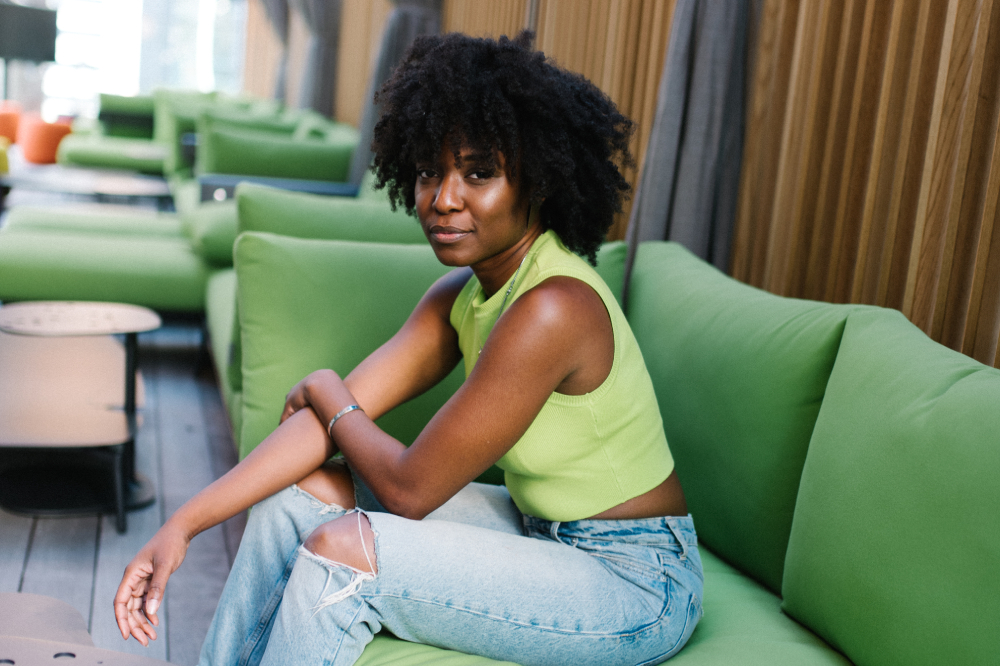Life
 Erin Douglas. Photo by Karston Tannis.
Erin Douglas. Photo by Karston Tannis.
Rising High in Black Rock Desert
June 30, 2022 @ 9:00am
In 2017, Baltimore-born and Maryland-based photographer and documentarian Erin Douglas was gifted a Burning Man ticket by a friend.
“I wasn’t excited. I was terrified. And I couldn’t pinpoint why,” she says.
As a solo world traveler, she acquiesced to sometimes being the only person of color during her journeys to parts unknown, but she wasn’t comfortable with that in the unfamiliar landscape of Burning Man, an annual pilgrimage by creatives to Nevada’s Black Rock Desert for a week of self-expression and community building.
Though the Burning Man Project explicitly states one of its 10 principles is “radical inclusion,” Douglas noticed a contrast between her experience — which was seeing more BIPOC Burners (dedicated attendees) than she had expected — and the underrepresentation in media depictions of the festival.
After returning home, she posted the photos she took of Black Burners she met during the weeklong creative celebration. The responses she received were revealing.
“People were saying, ‘I didn’t know we were invited. I didn’t know this was for us.’”
Since then, Douglas has been challenging that whitewashed notion through her “Black Burner Project” — a series of interviews and portraits of BIPOC festivalgoers. At this year’s festival, her original installation piece — “Black! Asé” — will ascend over 30 feet high in the desert and make Black Burners impossible to overlook.
“The Black Burner Project”
Douglas returned to Black Rock City in summer 2018 (and the next and the next), knowing that she could intervene through awareness and representation.
“And that was scary for me because I knew I wanted it to be bigger than just my Instagram page, I just didn’t know what that meant yet,” Douglas admits. “I tried to let go of this idea, but it wouldn’t let go of me.”
The Burning Man Project, which has a meticulously curated public image, then granted Douglas approval for her nascent project: photographing and interviewing Black and Brown Burners for her Instagram and website for her series “The Black Burner Project.”
“I wanted people to see themselves, and to share their stories,” Douglas states. “Let’s change the perspective of what people think Burning Man is, and what us, as Black and brown people, experience out there.”
Evolving over the last five years, her multimedia project is impressive in scope, clarity and connection. The 350+ portraits she has captured are beautiful and bold, inspiring and empowering, capturing moments of unabashed joy, unique style, artistic expression and community. Douglas pairs her powerful photos with short personal essays reflecting upon Black Lives Matter. During the 2020 Festival, she conducted over 80 Instagram interviews and stories. Likewise, the 70 “Stories from the Dust” interviews she has hosted — often stretching to an hour long — tell diverse experiences and memories, tips for newbies heading to the playa for the first time and opportunities for reflection among dedicated Black Burners.
Yomi Ayeni, a Black British Burner who heads the Burner-related public arts nonprofit We Are From Dust, approached Douglas to be on his board in support of Black artists. The proposal brought Douglas to the realization of a large-scale project, a culmination and expansion of her work so far.
“Black! Asé”
Douglas’ intimate, joyful portraits of Black Burners will soon tower as tall the Martin Luther King Jr. Memorial in the vast golden dust and azure sky of the playa.
The first Black artist-created photographic installation at Burning Man, the three 30-feet-high structures (representing the past, present and future) that comprise “Black! Asé” will be immersive, participatory and multisensory. — “a Yoruba word of affirmation, the power to do things, ‘So shall it be, so let it, and so it is’” — was central to Douglas’ message, as was affirming Blackness through the power of the people through the word “Black.”
Burners can climb the scaffolding connecting the portraits, lounge on seating and during the day find respite from the sun, or at night have a lighted nighttime playground. There will be audio clips from her many interviews looping, and “music you wouldn’t otherwise hear on the playa.” Douglas is creating a site to connect, relax, listen and reflect, but with this ascension, she is also activating a brave space for fellow Black Burners while elevating her role as an artist about to be known internationally and on a scale as epic as her installation piece.
“It was so important for the pictures to be seen, and for it to take up space, to be representative of the opposite of what we’re allowed to do as a people: take up space,” Douglas shares of this monumental project. “We’re always overlooked. So, I wanted it to be seen and to show the beauty of us.”
For this installation, she teamed up with architect Francesca Xavier — “She’s amazing and has been working her butt off!” — who has worked on several of the most famous Burning Man art installations, and now serves as the co-designer and creator of all the renders for “Black! Asé.”
In June, the prefabrication process will occur in Petaluma, California, at the studio of sculptor Marco Cochrane, who generously offered his space. Douglas plans to travel to California and Nevada several times during the next few months during the construction and installation. To fund the project, Douglas thanks her supportive community: she received an honorarium grant from the Burning Man Project, and through crowdfunding, courting generous donors and other fundraising events, Douglas is finalizing the funding for the project.
But, with the creation of “Black! Asé,” Douglas intends an extended life for this occasional piece.
“There are options,” Douglas says.
Touring installations in the Bay Area, the UK (where the nonprofit We Are From Dust is located), Oakland, the DMV and Baltimore (Douglas’ hometown) are being considered. Dream locations for Douglas also include, Art Basel and international locales TBD, fitting for the artist who is a world traveler and photographer.
Burning Man 2022 will take place from August 28-September 5. Revelers will be expected to practice another core principle “leave no trace.” There should be no waste left behind, no signs that an entire city took over the playa for a week.
With the creation of “Black! Asé” and its future home, the installation ensures the visibility of all BIPOC Burners after this summer’s festival, and there will be lasting traces: Spiritual and metaphysical imprints that will be seen and felt by generations of future BIPOC Burners.
Check out the Black Burner Project and support this project at blackburnerproject.com and on Instagram @blackburnerproject.
Visit Erin Douglas at erin-sha.com and on Instagram @aphotochick. And if you are attending this year’s Burning Man Festival, make sure to visit “Black! Asé.”







